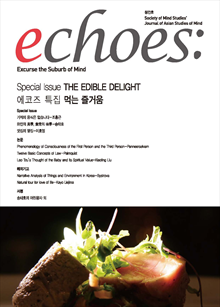간행물
Journal of Asian Studies of Mind 한국마음학회지

- 발행기관 한국마음학회
- 자료유형 학술지
- 간기 연간
- 수록기간 2014
- 주제분류 복합학 > 학제간연구 복합학 분류의 다른 간행물
- 십진분류KDC 189DDC 158
권호리스트/논문검색
제1권 제1호 (2014년 10월) 3건
Articles
1.
2014.10
구독 인증기관 무료, 개인회원 유료
The three important turns in philosophy in the twentieth century: linguistic (Wittgenstein), hermeneutical (Heidegger, Gadamer) and cognitive (Fodor, Churchland, Dennett).The interrelation among the above three turns and the significance of cognitive turn in philosophy is discussed in recent debates both in Indian and Western philosophical traditions. Thus consciousness reemerged as one of the problems of scientific (A.K. Mukhopadhyay, B.V. Sreekantan, Rajesh Kasturirangan) as well as philosophical community (R. Balasubramanian, Bina Gupta). Four types of responses to consciousness: D-I-M-E (Deflation, Irreducibility, Magic and Eliminativism).
4,000원
2.
2014.10
구독 인증기관 무료, 개인회원 유료
This fourth article in a six-part series correlating Kant’s philosophy with the Yijing begins by summarizing the foregoing articles: both Kant and the Yijing’s 64 hexagrams (gua) employ “architectonic” reasoning to form a fourlevel system with 0+4+12+(4x12) elements, the fourth level’s four sets of 12 correlating to Kant’s model of four university “faculties”. This article explores the second twelvefold set, the law faculty. The “idea of reason” guiding this wing of the comparative analysis is immortality. Three of Kant’s “quaternities” correspond to three sets of four gua in the Yijing: the fourfold nature of the soul in rational psychology (as substantial, simple, unified, spatially related) corresponds to gua 47, 6, 58, 10, respectively; the three “Definitive Articles” and fourth, “Secret Article”, in Perpetual Peace correspond to gua 16, 35,51, 21; and the four objective relations of law to duty in Metaphysics of Morals correspond to gua 45, 12, 17, 25.
4,300원
3.
2014.10
구독 인증기관·개인회원 무료
The “infant” plays an important role in the Eastern monastic tradition. There has been a lot of discussions in the works of Buddhism and early Christianity. As a comprehensive theoretic system, however, the theory of “infant” is mainly in the ideological system of Taoists. The “infant” is treated as the highest goal in the monastic practice of Lao Tzu.

